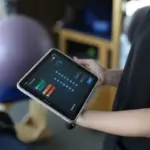Treatment for spasticity is one of the great benefits of epidural stimulation. Spasticity is a common feature of spinal cord injury (SCI) and is defined as a “velocity dependent increase in muscle tone”. It often causes spasms, which are sporadic muscle movements. In SCI, this is due to impaired spinal cord pathways responsible for regulating muscle tone and movements. Both spasms and spasticity are features of what is called an “upper motor neuron syndrome”. Upper motor neuron syndrome is a result of an injury to the upper motor neuron pathways. These originate from the motor cortex in the brain, pass through the brainstem and come all the way down towards the lower end of the spinal cord. These pathways then synapse with what are called “lower motor neurons”, which in turn leave the spinal cord and brainstem and provide nerve supply to the corresponding muscle groups.
How is Spasticity Developed?
After an injury to the brain or the spinal cord, the upper motor pathways are injured, and they are no longer able to regulate the function of lower motor neurons. Ultimately, they lose control over their muscle tone and movements. Depending on the location of the injury, nature of the injury and which upper motor pathways are involved, different patients develop different kinds of spasticity and spasms. There are two common types, firstly tonic spasticity, which is a result of persistently increased muscle tone and persistent muscle contractions. Secondly, phasic spasticity, which is an unusual stretch reflex, rather than a persistent increase in muscle tone. Many patients, over the evolution of their injury, suffer from both types of spasticity.
What is The Significance of Spasticity?
Post-SCI, the extent of muscle tone, spasticity, and spasms can reveal important information about the location and nature of the lesion. After severe trauma, patients go through a condition of “spinal shock” which shuts down the spinal cord. Over the course of a few days to a few weeks, the spared spinal pathways, which were left uninjured or partially injured, start to recover and produce muscle tone, albeit very abnormal muscle tone. Spasticity, in this sense, could be termed as a feature of a partial spinal cord lesion rather than a complete lesion. This is because a complete lesion results in an absolute lack of any communication below the level of injury.
What Are The Current Treatments for Spasticity?
There is no single treatment option that can successfully manage spasticity in all individuals. Conventionally, the most conservative tactics are utilized first, with the following progression:
- Physical rehabilitation modalities
- Pharmacologic interventions
- Injection techniques
- Intrathecal baclofen
- Surgery
Pharmacological intervention, which includes baclofen, tizanidine, clonazepam, other antispasmodic medications and in some cases botulinum toxin, is useful for many patients, at least for an initial period of time. Regular stretching and physical exercise can also play an important role in managing muscle tone.

How Does Epidural Spinal Cord Stimulation Help?
Spinal cord stimulation uses low-intensity electrical currents, applied to specific parts of the spinal cord. This method is used to treat neuropathic pain as well as to restore muscle function after a severe spinal cord injury. Over the period of many years, the Verita Neuro team has consistently noticed that many spinal cord injury patients, initially suffering from severe spasms and spasticity, reported improvements in their muscle tone and spasms. This is attributed to the ability of the long-term stimulation of the spinal cord to regulate and optimize the function of upper motor pathways. This results in a significant reduction in the dosages of pharmacological solutions required, and significantly improved management of spasticity and spasms.
References:
- Lance J.W. (1980) The control of muscle tone, reflexes, and movement: Robert Wartenbeg lecture. Neurology. 30:1303.
- Pandyan A.D., Gregoric M., Barnes M.P., Wood D., Van Wijck F., Burridge J., Hermens H., Johnson G.R.(2005) Spasticity: Clinical perceptions, neurological realities and meaningful measurement. Disabil. Rehabil.27:2–6.
- Holtz K.A., Lipson R., Noonan V.K., Kwon B.K., Mills P.B. (2017) Prevalence and Effect of Problematic Spasticity After Traumatic Spinal Cord Injury. Arch. Phys. Med. Rehabil. 98:1132–1138.
- Skoog B., Jakobsson K.E. (2020)Prevalence of Spasticity and Below-Level Neuropathic Pain Related to Spinal Cord Injury Level and Damage to the Lower Spinal Segments. J. Rehabil. Med. Clin. Commun. 3:1000039.
- Boyd I.A. (1976) The response of fast and slow nuclear bag fibres and nuclear chain fibres in isolated cat muscle spindles to fusimotor stimulation, and the effect of intrafusal contraction on the sensory endings. Q. J. Exp. Physiol. Cogn. Med. Sci. 61:203–254.
- Midha M., Schmitt J. (1998) Epidural spinal cord stimulation for the control of spasticity in spinal cord injury patients lacks long-term efficacy and is not cost-effective. Spinal Cord volume 36, pages 190–192






